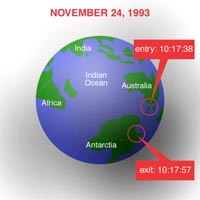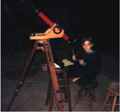
Department of Geological Sciences


|
|---|

David P. Anderson is Senior Systems Analyst and Director of the Imaging
Laboratory in the Department of Geological Science's Center for Geophysics
at Southern Methodist University.

We began
modeling the surface of Venus in 1989
under a NASA grant for the Magellan project with Roger Phillips,
one of it's principal investigators. Over the next few years
we developed tools for generating three-dimensional imagery from
the massive Magellan data sets, and began to produce a series of detailed
pictures of geologic structures on Venus.
 These images have been featured in the pages of scientific journals and magazines like Science,
Scientific American, Discover, Sky and Telescope, Der Spiegel
and others in Europe and Japan, over 350 publications as of April 2003, as well as astronomy
texts and encyclopedia,s including a three page foldout in the February 1993 issue of
National Geographic.
These images have been featured in the pages of scientific journals and magazines like Science,
Scientific American, Discover, Sky and Telescope, Der Spiegel
and others in Europe and Japan, over 350 publications as of April 2003, as well as astronomy
texts and encyclopedia,s including a three page foldout in the February 1993 issue of
National Geographic.

Discover Magazine featured an article in December 1993 about our work on a
unique 3-D rendering technique
developed in the SMU Imaging Laboratory for generating fine scale surface
features from the NASA elevation and radar data measured by the Magellan space probe. The technique
capitalizes on the relationship between radar reflectivity and surface roughness to re-create
subtle features not available from the raw altimetry data.


"The Solar System" model, a permanent installation at the Smithsonian Museum
on the National Mall in Washington, D.C., includes ceramic plaques of each of the
planets. The Venus station, pictured here, features an image from of NASA Magellan
Spacecraft data of Maxwell Montes, tallest mountains in the Solar system, by
"David P. Anderson, Department of Geological Sciences, Southern Methodist University."
A series of 3D images and animations of the Venus landscape were modeled by David in the SMU Geophysics
Imaging Lab for the
Scientific American Library which has since been released on CDROM.

 We worked for five years with the Department of Geophysics at SMU
and the Los Alamos National Laboratory
modeling seismic data from earthquakes and
mining explosions, as part of an effort
to develop techniques for seismic detection and discrimination of nuclear events, as part of an on-going
research effort in support of the Comprehensive Test Ban Treaty.
We worked for five years with the Department of Geophysics at SMU
and the Los Alamos National Laboratory
modeling seismic data from earthquakes and
mining explosions, as part of an effort
to develop techniques for seismic detection and discrimination of nuclear events, as part of an on-going
research effort in support of the Comprehensive Test Ban Treaty.
 This led to the development of a series of techniques for
imaging seismic energy as particle motions,
surface motions, 3-D wave fields, and color and shading gradients. Similar models were developed for
analyzing large-scale mining explosions and for both near and far-field measurements. These models were
used by seismologists and also by mining engineers to better understand the mechanisms that couple
the energy of explosions into the surrounding rock.
This led to the development of a series of techniques for
imaging seismic energy as particle motions,
surface motions, 3-D wave fields, and color and shading gradients. Similar models were developed for
analyzing large-scale mining explosions and for both near and far-field measurements. These models were
used by seismologists and also by mining engineers to better understand the mechanisms that couple
the energy of explosions into the surrounding rock.
 Together with scientists at SMU and Los Alamos National Laboratory we generated a series of papers
based on the field experiments of
Brian Stump to analyze the structure
of industrial explosions and the source mechanisms with which they create seismic energy, by combining
multiple data sets from accelerometers and seismometers with broad-band acoustic and video records,
all synchronized with GPS clocks. These data provide new insights into the creation of seismic and
acoustic waves by explosive forces and their interrelation.
Together with scientists at SMU and Los Alamos National Laboratory we generated a series of papers
based on the field experiments of
Brian Stump to analyze the structure
of industrial explosions and the source mechanisms with which they create seismic energy, by combining
multiple data sets from accelerometers and seismometers with broad-band acoustic and video records,
all synchronized with GPS clocks. These data provide new insights into the creation of seismic and
acoustic waves by explosive forces and their interrelation.
 Our recent work includes the search for
strange quark matter with Eugene Herrin (seismology), Vigdor Teplitz (physics)
and Ileana Tibuleac (geophysics) using the facilities of the SMU Geophysical Seismology
network, the United States Geological Services (USGS) and the U.S. Department of
Energy (DOE).
Our recent work includes the search for
strange quark matter with Eugene Herrin (seismology), Vigdor Teplitz (physics)
and Ileana Tibuleac (geophysics) using the facilities of the SMU Geophysical Seismology
network, the United States Geological Services (USGS) and the U.S. Department of
Energy (DOE).
An exotic form of extremely dense matter may, if it exists, periodically strike the
earth and be detectable from the seismic energy released by its passage. Traditional seismic theory
depends on point sources for very small events like this, and so would not detect the passage of
such a particle. The team has developed and deployed a "linear event recognizer" to search for
just such events.

In my spare time I enjoy:
 building robots
building robots
 making music
making music
 music for dance
music for dance
 star gazing
star gazing
 my family.
my family.
and here's a link to my
weblog

Geological Sciences Archives
Geophysical Imaging Compound
Geology Home Page
last update: 29 April 2010 dpa